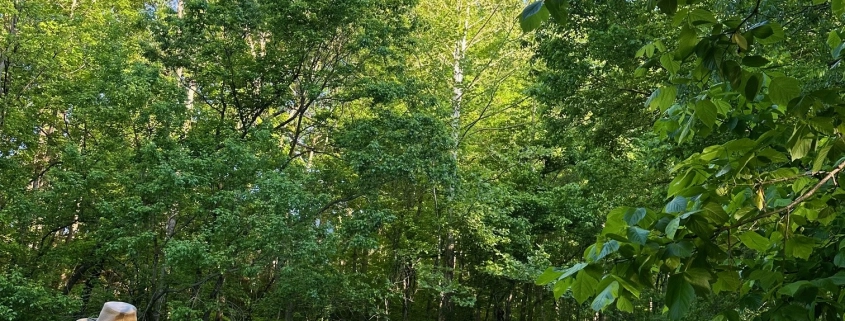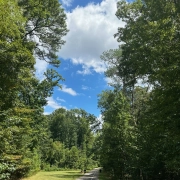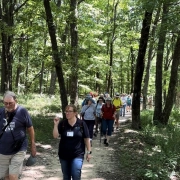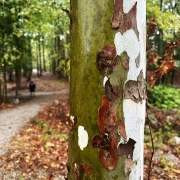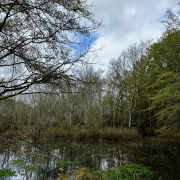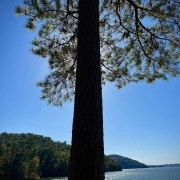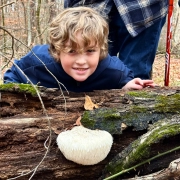Brief-Form Post #34: Late April Birding Exploration at Madison, Alabama’s Creekwood Park and Indian Creek Greenway!
I am pleased to add the 34th of my GBH Brief Form Posts (Less than five minutes to read!) to my website. I tend to get a bit wordy with my routine Posts. I don’t want my enthusiasm for thoroughness and detail to discourage readers. So I will publish these brief Posts regularly.
I am a wanna-be birder, a lifelong Nature enthusiast with a Forestry BS and a PhD in Applied Ecology, and a woodland wanderer wherever my life and travels have taken me. I’ve lived in Maryland, New York, Pennsylvania, Virginia, Georgia, Ohio, New Hampshire, North Carolina, West Virginia, and Alaska. I’ve journeyed to and through every state except Hawaii. International travels included Canada, Finland, Sweden, Norway, Kazakhstan, China, Japan, Germany, the Czech Republic, and Yugoslavia. I’ve heard and seen birds everywhere and wished to know their identity and story.
Finally, five years into retirement, I stepped toward learning more about the avian world. I enrolled in a University of Alabama in Huntsville OLLI (Osher Lifelong Learning Institute) North Alabama Birding course taught by Alabama A&M Professor Emeritus of Ornithology, Dr. Ken Ward. Our capstone field lab on April 25, 2024, took us to Madison Alabama’s Creekwood Park and adjacent Indian Creek Greenway, an area Ken described as a spring migration hotspot.
And so right he was! We (he) tallied 68 bird species seen, both seen and heard, or heard. You can review his comprehensive list at the end of this Post. I admit to deferring to his lifetime-trained ears for identifying species by call. He also spotted and identified fleeting images of treetop and brush inhabitants. I have a long way to go to become even an amateur birder. My knowledge and skills can go only in one direction. Ken and my classmates opened me to better ways of looking, hearing, and seeing.
I knew coming into the course that diverse habitats enrich species diversity, whether plants or all manner of living creatures. The Park and Greenway offered such diversity. Open meadows, mowed grass, woods edge, forest, stream, bog, and swamp comprised the areas we observed.
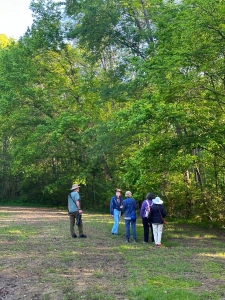
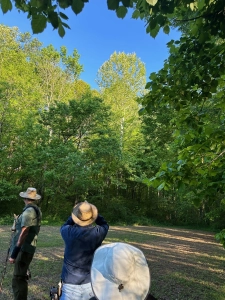
Our spirits soared on a perfect weather morning. Smiles and enthusiasm prevailed, along with a sense of wonder and awe for the avian variety we encountered.
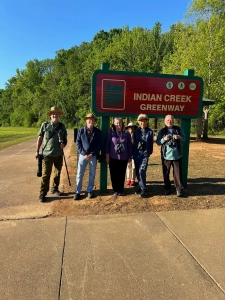
Indian Creek had overflowed its banks more than once over the winter and spring. The forest below retained flood water not yet absorbed or drained, just one of the diverse habitats.
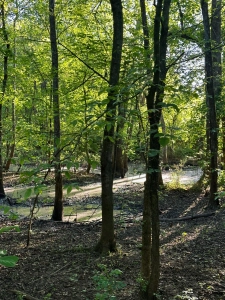
Indian Creek provided fresh flowing water. A mallard drake paddled contentedly at right.
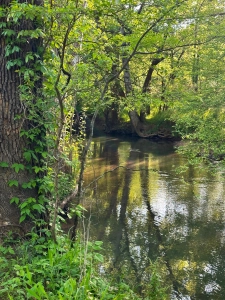
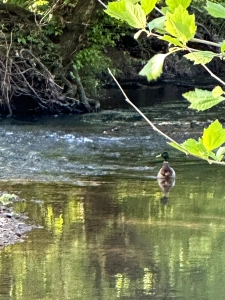
I recorded this 60-second video of the stream at Creekwood Park
A willow thicket at the Park attracted throngs of cedar waxwings foraging willow seeds.
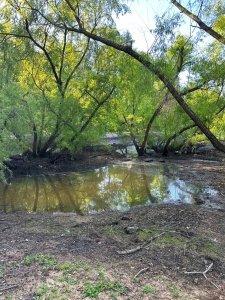
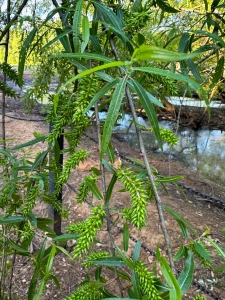
A small feeder freshet surged past butterweed blooms before emptying into Indian Creek.
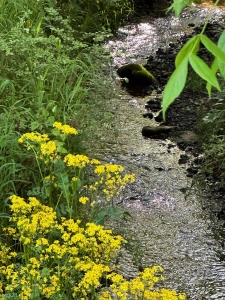
I recorded this 30-second video of Indian Creek along the Greenway.
Beavers keep the wetland and swamp habitat intact south of the park along the Greenway.
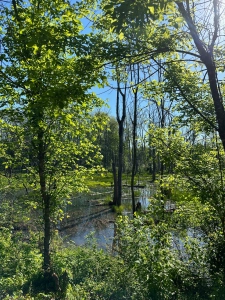
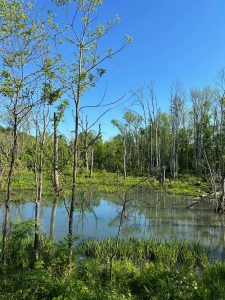
The forester and tree enthusiast within me could not resist this park eastern red cedar, its roots tracing a comprehensive highway map.
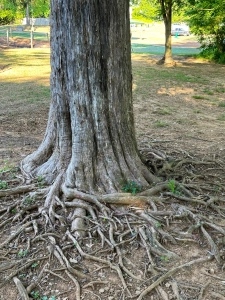
I accept the challenge of distilling these Brief-Form Posts into a single distinct reflection, a task far more elusive than assembling a dozen pithy statements. Today, I borrow the words of John James Audubon:
- If only the bird with the loveliest song sang, the forest would be a lonely place. Never give up listening to the sounds of birds.
NOTE: I place 3-5 short videos (15 seconds to three minutes) on my Steve Jones Great Blue Heron YouTube channel weekly. All relate to Nature-Inspired Life and Living. I encourage you to SUBSCRIBE! It’s FREE. Having more subscribers helps me spread my message of Informed and Responsible Earth Stewardship…locally and globally!
Appendix
Ken Ward’s tally for our excursion to Creekwood Park and Indian Creek Greenway, Madison, Alabama, US Apr 25, 2024 7:07 AM – 11:37 AM
Protocol: Traveling
4.5 mile(s)
68 species
Canada Goose 10 (species followed by number of individuals observed)
Mallard 6
Mourning Dove 8
Chimney Swift 4
Solitary Sandpiper 2
Great Egret 1
Great Blue Heron 5
Turkey Vulture 1
Bald Eagle 1
Red-shouldered Hawk 2
Belted Kingfisher 3
Red-bellied Woodpecker 14
Downy Woodpecker 10
Pileated Woodpecker 2
Northern Flicker 3
Eastern Wood-Pewee 4
Eastern Phoebe 5
Great Crested Flycatcher 1
Eastern Kingbird 2
White-eyed Vireo 8
Yellow-throated Vireo 1
Red-eyed Vireo 2
Blue Jay 10
American Crow 5
Carolina Chickadee 2
Tufted Titmouse 14
Northern Rough-winged Swallow 4
Barn Swallow 8
White-breasted Nuthatch 2
Blue-gray Gnatcatcher 5
House Wren 1
Carolina Wren 20
European Starling 10
Gray Catbird 4
Brown Thrasher 1
Northern Mockingbird 6
Eastern Bluebird 6
Wood Thrush 2
American Robin 30
Cedar Waxwing 35
House Finch 6
American Goldfinch 14
Chipping Sparrow 2
Field Sparrow 6
Song Sparrow 4
Eastern Towhee 1
Yellow-breasted Chat 1
Eastern Meadowlark 1
Orchard Oriole 1
Baltimore Oriole 1
Red-winged Blackbird 15
Brown-headed Cowbird 14
Common Grackle 27
Northern Waterthrush 2
Prothonotary Warbler 2
Tennessee Warbler 12
Nashville Warbler 1
Common Yellowthroat 2
Northern Parula 4
Yellow Warbler 2
Palm Warbler 1
Yellow-rumped Warbler 16
Yellow-throated Warbler 1
Summer Tanager 8
Scarlet Tanager 1
Northern Cardinal 25
Rose-breasted Grosbeak 1
Indigo Bunting 14

